| 1 | A harmless earthworm obsessive |
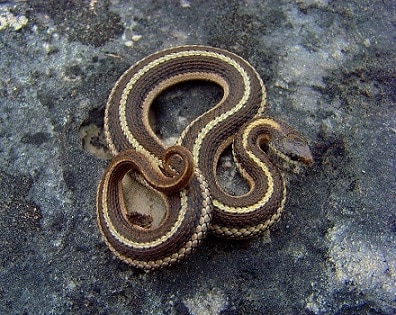
The lined snake is a species that few ever see, and if they did, they would probably be bombarded by herpetologists turning up on their doorstep. This is an American snake which occupies a chunk of the former great plains, without crossing into Canada, and just extending into Texas. They spend much of their time underground, as they’re designed for excavating and enlarging mammal burrows. Even when above, they normally rest under cover. This is a non-venomous snake which doesn’t even bite in self defence, and largely moves by night.
Lined snakes are extremely shy, and are most often spotted on roads. The best way to find one in the wild is to walk around turning over rocks in moist plains. The bulk of the range lies in Kansas and Nebraska, but there are scattered colonies in northern and central Illinois, southeast Iowa, New Mexico, and eastern Colorado.
New locations for this shy snake are regularly discovered. In Wisconsin, they were discovered for the very first time in 2011, 95km from its previously known territory in Jo Daviess County, Illinois. Corey Raimond found one a wet prairie, lurking behind a rock which he lifted.
| 2 | Hates being exposed |
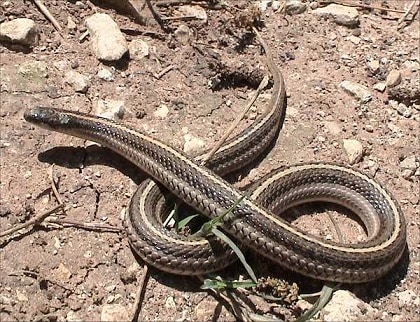
The best time to see lined snakes is in heavy rains at spring. This is when they emerge from their underground hidey-holes, whereas in hot, dry summers they tend to stay below. They emerge from hibernation in March, and their hibernation spots are usually 6-8 inches below soil.
Above ground, lined snakes like to lurk beneath cover. In urbans areas, they’re found beneath boards, broken pieces of tile, and cement building blocks. Like the Kirtland’s snake, vacant lots adjacent to dwellings are a likely space to spot them.
They’re quite a calm snake, as if you rip up their cover and leave them exposed to the elements, they usually don’t react. They don’t get frightened, nor flee into the grass in a panic. However, they do wrestle violently when picked up. They rarely bite, but produce a vile snake smell. Several lined snakes can be found below their cover objects at once, and they usually rest in a loose coil.
| 3 | Sniffs out earthworm molecules |
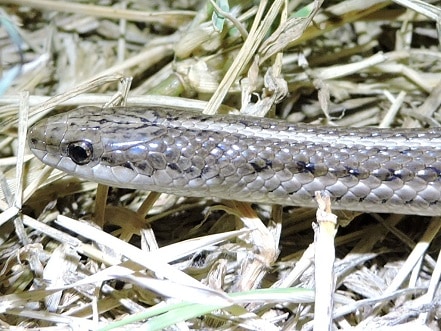
The lined snake’s diet is an everending buffet of small, slimy earthworms, which it slurps down without need for venom. When choosing their dens, they specifically go for areas that are crawling with earthworms. These can include American natives like Diplocardia or introduced earthworms like Lumbricus terrestris.
However, lined snakes aren’t completely restricted; they can also eat sow bugs, slugs, and snails. One theory is that these once made up more of their diet, but now that invasive earthworms from Europe are all over the US, they can abandon caution and eat their favourite meal all day.
In captivity, lined snakes are happy to eat whole earthworms, or cut earthworms in a dish. The garter snake also eats earthworms, and scientists discovered that their nasal system can detect the scents of cuticle collagen-like substances produced by their slimy bodies. Given their close relation, lined snakes may also have this earthworm homing device.
| 4 | ID: half-moon belly patterns |
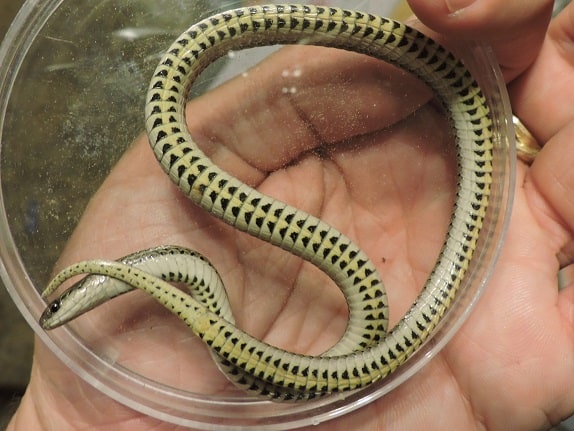
The lined snake is named for the parallel stripes running down their backs, and this can lead to confusion with local garter snakes. Lined snakes are the sole member of the family Tropidoclonion, but their closest related family on the evolutionary tree is the garter snakes (thamnophis).
One difference is the belly, as lined snakes have an extra staircase-style pattern of black scales which garter snakes lack. Others have described these patterns as half moon-shaped. These patches contrast sharply against the white belly, which is always lighter than their backs. Some snakes have spots on the edges of their belly, but the lined snake is the only one to have them right in the centre.
The lined snake has a stripe running down the centre of its back, which varies from yellow to orange. Like garter snakes, there’s an extra parallel stripe on each flank. The lined snake’s body colour varies significantly, from chocolatey brown to beige or grey.
| 5 | Master of soil tunnels |
In 2005, one forum member acquired a state licence to keep a lined snake in captivity. He found one in roadside ditch, and set about constructing an epic container for its home. The first ingredient was a ten gallon aquarium, followed by an inner rectangle of flexi-glass, which was see-through to observe the lined snake’s behaviour. The container was filled with loose soil, designed to mimic the lined snake’s natural habitat. Then came moss, quartzite, a layer of grass clippings, mulch, and bark chippings.
Finally, he added the snake, and a first batch of earthworms. The snake was agitated from the get-go, always retreating to chambers within the soil. Its favourite spot became the crevice between the surface quartz rocks, giving it cover like in the wild. Eventually, the lined snake decided to explore the tunnels made by tiny earthworms. Poking its head down, it expertly enlarged the tunnels, and travelled through them using its cylindrical body. The owner watched through see-through glass as it penetrated deeper and deeper into the soil. Eventually the lined snake found a cosy chamber lower down which it made its home, with barely enough room to lift its head.
The owner was also able to watch as the lined snake caught an earthworm scent. Its facial expression changed, and then the slow pursuit was on, through the underground passages. The lined snake waited around corners, with just its head visible. At the opportune moment, it grabbed the earthworm and sucked it down, all while navigating through the ultra-narrow tunnels like a pro. If a rattlesnake tried to live the lined snake lifestyle, it would fall flat on its face. According to the owner, the lined snake never became used to his presence.
| 6 | Common after heavy downpours |
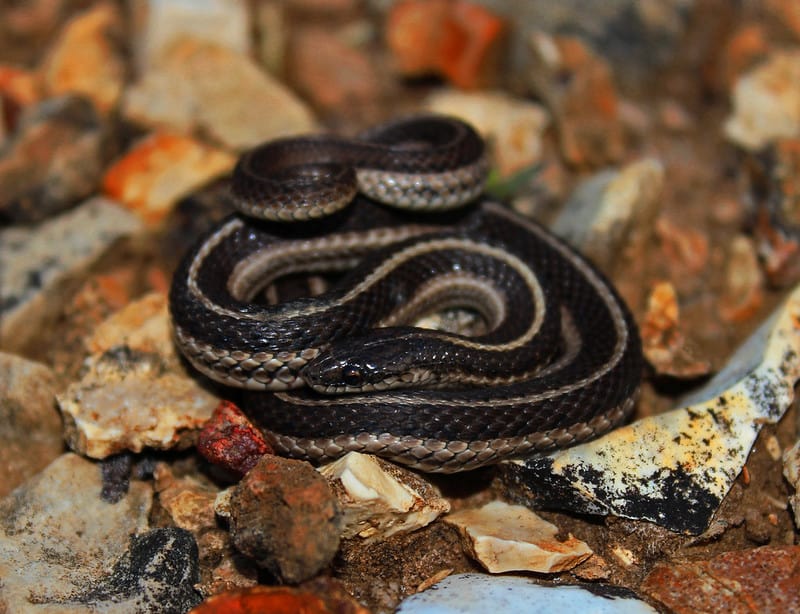
In the wild, lined snakes love open forests and moist grasslands. Dry plains and regularly flooded river meadows are no good, but constantly soft soils where they can find vacant burrows.
The lined snake’s favourite time to hunt is the hours just after a heavy downpour. This is the time when their earthworm prey comes out in huge numbers, and the forest is full of possibilities. Lined snakes can cope with some manmade habitat disturbance, but have a nasty tendency to be run over on roads.
They also fall victim to prescribed fires, such as when farmers burn off old hay fields to restore floral biodiversity. In 2020, researchers in Hay County, Nebraska discovered a charred and destroyed lined snake in the ashes of such a fire. They’re less skilful at dodging than the Louisiana pinesnake, which is completely immune to fires, and can skip into its underground burrows with seconds to spare.
| 7 | Rarely exceeds 50cm |
The lined snake is a tiny species, so short that it can’t even match a 2 year old black mamba’s tail. The record adult length was a mere 57.2cm, and the adult average is 22-38cm. The lined snake’s head is sleek and long, barely separate from its neck, and its scales are rough to touch (keeled). The newborns are barely longer than a pencil, at 7-13cm.
Female lined snakes are able to reproduce yearly, usually with 2-11 hatchlings. They mature at 2 years, and are ovoviviparous, laying live young, with the mother pumping in nutrients and building blocks from her own body.
Unfortunately, the lined snake also commits the act of cannibalism. One mother in captivity gave birth to 12 live babies. There was no way to escape the cell, and when the scientists returned, only 6 young remained. The evidence pointed one way, and the mother was later spotted eating another. The next morning, 4 remained.
| 8 | Found at 2800 metres |
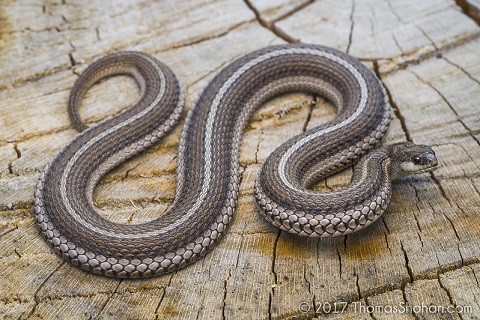
In most of its territory, the lined snake exists at lower altitudes, always below 1500 metres. The exception is the western flanks, where it hits the Rocky mountains. Here, lined snakes are more adventurous and have been spotted at over 2000 metres. One was spotted at 2035 metres in New Mexico, and in 2009, a new record was set when a lined snake was seen slithering around a grazed montane meadow at 2810 metres, surrounded by ponderosa pine and gambel oak.
The location was Capilla Peak, again in New Mexico. This was also the first discovery on the peak, and lined snakes are equally unmapped in other places. In Minnesota, the sole spot where they’re confirmed is Blue Mounds State park, first discovered in 1980. There was a question mark over this sighting for decades, with the best being one road-killed line snake in 1984. Finally, one adult and 2 juvenile lined snakes were captured in a 2006 expedition. All efforts to find them outside the park have failed.
| 9 | Declining in some states |
The lined snake’s Latin name is Tropidoclonion lineatum, which contains 3 elements. Tropidoclonion contains trophis, the Greek word for keel (rough), followed by klon, the Greek word for twig. Lineatum translates from Latin as “of a line”, derived from lineatus.
With its similarities to garter snakes, this species went unnoticed for a while. The lined snake was only scientific described for the first time in 1856, nearly 100 years later than the black racer (1758). This first lined snake was unearthed at Fort Riley, Kansas, along the Kansas river, by post surgeon William A. Hammond.
As for the future, lined snakes aren’t massively endangered, but have been listed as threatened in Illinois since 2004. In Iowa, their habitats are declining particularly rapidly. The situation is murky, because it’s hard to spot them at the best of times. A lined snake’s camouflage is amazing on anything but the greenest grass, and they’re a small snake which is easy to walk right past. Many frustrated herpetologists have probably walked right past them on rolling prairie meadows.
| 10 | Low on the food chain |
The lined snake’s excellent camouflage doesn’t save them from their fellow snakes. Compared to its kingsnake relative, the milksnake (Lampropeltis triangulum) eats snakes far less frequently. However, a study in the western US on 180 milksnake prey items found that the lined snake was the sole serpent to appear. 175 milksnakes were studied in total.
Another study encountered 161 Texas desert massasaugas. Mammals made up 79.5% of their prey, with 6 snakes found in their bellies. Of those, the only one identifiable was a lined snake. Then there’s the black racer (Coluber constrictor), a fast and manically active snake. According to a study from Hall County, Nebraska, the lined snake is a confirmed part of its diet. Interestingly, another study found that the lined snake was the 5th most common by the Wood River in Hall County, so this may be one of its hotspots.
On the other hand, the lined snake has no problem with hibernating with its common garter snake relative. One spot is vast piles of warm cow manure, but more common is old animal burrows. Lined snakes emerge later than garter snakes in the same neighbourhoods, usually early April rather than late February.
